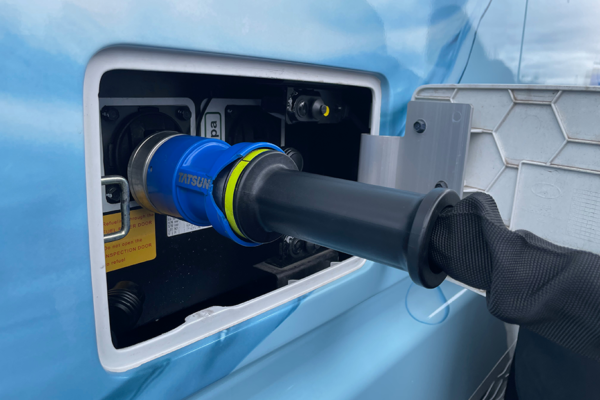Article created for the digital issue of the NATSO Foundation’s magazine
FirstElement Fuel has created what it calls the world’s first fast-fueling hydrogen fueling station. The facility, located at the Port of Oakland, will serve commercial trucks and the motoring public. The station, which operates under the True Zero brand, is capable of filling 200 trucks a day in just 10 minutes each using proprietary pump technology that enables the rapid fueling times.
The Oakland station:
- Can deliver 18,000 kilograms of hydrogen daily;
- Has two heavy-duty truck fuel pumps; as well as
- Four light/medium-duty dispensers supplied by liquid hydrogen.
Listen to FirstElement Fuel Launches Heavy-Duty Hydrogen Fueling Station: How, Where and More.
What Are Their Plans?
Those plans include about a dozen commercial hydrogen fueling locations designed for heavy-duty applications that will be constructed over the next five to seven years. Ghassan Sleiman, chief technology officer for FirstElement Fuel (FEF), said the company is securing land and building locations from the ground up, but it doesn’t have plans to add driver amenities to the sites.
Hyundai and Nikola
Slieman said FEF has completed more than 200 fills on heavy-duty trucks, most of them with Hyundai, which is fueling a fleet of 30 Hyundai XCIENT day cab tractors at the site. Global Expedited Transportation is operating the Hyundai trucks in its drayage applications.
Additionally, Nikola has entered into a 10-year contract to fuel its trucks at the site, and the station will open to the public once final inspections are completed in May.
Cryopump Technology Turns Liquid Hydrogen Into a Gas at the Pump
The fast fills are possible due to cryopump technology that turns liquid hydrogen, stored at -423 Fahrenheit, into a gas right at the pump. FEF designed the cryopump in-house, and has partnered with Bosch Rexroth to create a high-volume, high-performance cryopump it will use going forward.
The companies are currently testing the technology, which Stephens called “a major breakthrough,” at its proving grounds in Livermore, California.
The benefit of using liquid hydrogen is that it is more dense than gaseous hydrogen, so it requires a smaller footprint—just 1/30th of the space—at a fueling station. Plus, Stephens said about ten times more can fit into a trailer.
Air Liquide station Produces the Liquid Hydrogen
FEF’s liquid hydrogen is produced at an Air Liquide station near Las Vegas and trucked to Oakland. Stephens said the company has contracted with Pilot Company to deliver the fuel.
A concern with hydrogen is the “boil off” that occurs as fuel warms and hydrogen starts venting.
Once boil off occurs, it will vent about 1% a day. However, as long as at least 1% of a tank’s volume is used each day, it isn’t an issue, Sleiman said.
Will Hydrogen Play a Critical Role in Trucking?
Eugene Litvinov, director of commercial vehicle and hydrogen business development at Hyundai Motor North America, said hydrogen will play a critical role in trucking because of its high energy density. “Hydrogen fuel cell vehicles offer advantages in heavy duty trucking that BEV cannot,” he said.
They can provide a longer driving range, about 450 miles, haul a full payload, and be refueled quickly. Stephens said the fueling experience is similar to what drivers are already used to today, using a nozzle to connect the fuel pump to the truck. “The driver doesn’t have to do anything out of the norm like they would with batteries,” he said.
Litvinov said drivers like the hydrogen trucks. “From the drivers’ perspective, it is a far superior product. There is powerful acceleration and great performance. A lot of the feedback from the drivers is they don’t feel as fatigued,” he said.
However, hydrogen costs more than diesel, costing about twice the price of diesel. Stephens said the price will come down as adoption increases. Subsidies can also help. FEF received funding from the California Air Resources Board and the California Energy Commission for the Oakland station and is a Tier 1 Partner in California’s Hydrogen Hub initiative, ARCHES, which received a $1.2 billion award from the U.S. Department of Energy.
Liane Randolph, chair of the California Air Resources Board, said she doesn’t see an “either/or” decision when it comes to hydrogen and BEVs. “There are use cases for both,” she said.
// This article was created for Stop Watch magazine, the magazine of the NATSO Foundation. The NATSO Foundation is the research, education and public outreach subsidiary of NATSO, Inc. The NATSO Foundation provides programs and products to strengthen travel plazas’ ability to meet the traveling public's needs through improved operational performance and business planning. Visit www.natsofoundation.org for more information. (Donate to the NATSO Foundation here.)
Subscribe to Updates
NATSO provides a breadth of information created to strengthen travel plazas’ ability to meet the needs of the travelling public in an age of disruption. This includes knowledge filled blog posts, articles and publications. If you would like to receive a digest of blog post and articles directly in your inbox, please provide your name, email and the frequency of the updates you want to receive the email digest.




